#cintamani
Text

Bodhisattva Cintāmaṇicakra, 9-10th century
Heian period, Japan
Wood, single block construction
Height: 94.9
Important Cultural Property
The legend said that this statue was discovered in the sea of Tango region. The carving technique of the early Heian period can be seen on the stern face with connected eyebrows, as well as the thick and broad body structure. The scarf-like cloth (jōhaku) was draped widely which is rare to see, it leads a theory that this statue belongs to the Tendai sect.
Collection of the Nara National Museum
#Avalokitesvara#Buddhism#bodhisattva#figure#religion#kannon#Japanese#觀音#cintamanicakra#cintamani#sculpture#wood#carving#9th century#10th century#art#art history#Nara National Museum#iconography#gesture#Heian period#symbolism
290 notes
·
View notes
Text
Buddhist Dragon Balls
I first became interested in Journey to the West thanks to the manga/anime Dragon Ball Z. The series is named after a set of seven glass-like orbs (fig. 1) that were created by the Namekian-turned-protector deity Kami for the benefit of mankind. When all seven are collected, they summon the dragon god Shenron, who grants a single wish. One common wish is to resurrect a beloved fighter who had previously been killed in battle.
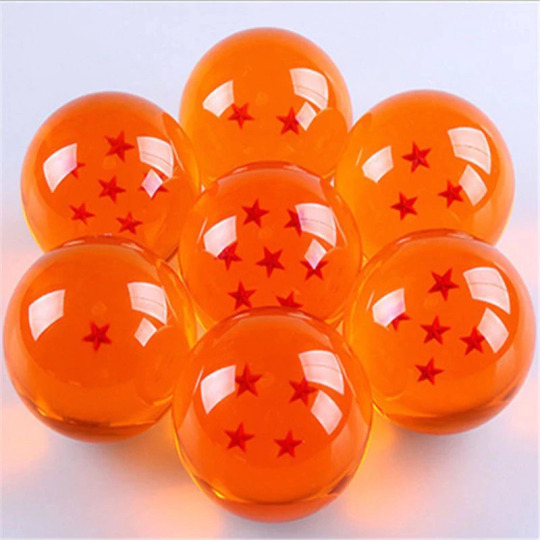
The seven dragon balls.
But what would the Dragon Balls be like if they appeared in the Journey to the West universe? There are two possibilities. The first is the most obvious, the Cintāmaṇi (Sk: "wish-fulfilling jewel"; Ch: ruyi baozhu, 如意寶珠, lit: "as-you-will treasure jewel"). Also known as "dragon jewels" (longzhu, 龍珠), these luminous orbs are commonly held by Bodhisattvas in Buddhist art (fig. 2), thereby signifying their ability to grant any wish that a believer may have. They are also mentioned in Buddhist scripture. For instance, the Treatise of the Great Perfection of Wisdom (Sk: Mahāprajñāpāramitāśāstra; Ch: Da zhidu lun, 大智度論, c. 2nd-century) reveals that the Cintāmaṇi is a bodily relic found in the brains of dragon kings (longzhu chu longnao zhong, 龍珠出龍腦中) (Buswell & Lopez, 2014, p. 193). Therefore, we would be able to maintain the connection to dragons in Journey to the West.

A 14th-century Korean painting of the Earth Store Bodhisattva holding a Cintāmaṇi.
In East Asia, the Cintāmaṇi is closely associated with our second possibility, the Śarīra (Sk: "body"; Ch: Sushe/zi, 舍利/子) (fig. 3). These pearl-like beads figure among the bodily relics left over from the historical Buddha's cremation. [1] Strong (2004) explains: "[They are the result] of a process of metamorphosis brought on not only by the fire of cremation but also by the perfections of the saint (in this case the Buddha) whose body they re-present" (p. 12).
They are said to come in different colors and sizes depending on the country and religious tradition (Strong, 2004, p. 11).
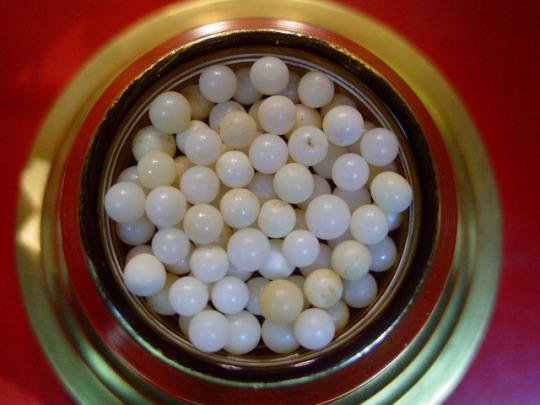
Photo of Śarīra relics.
Journey to the West could have one or even both of these bodily relics. For example, the Cintāmaṇi would allow demon kings or lesser spirits to wish for powerful heavenly weapons, thereby helping them fight stronger opponents; or, the Śarīra could grant the devils more spiritual power, thereby allowing them to bypass centuries of spiritual cultivation.
But neither of these items could help evil beings achieve immortality. I've previously noted that Journey to the West was heavily influenced by the Buddho-Daoist philosophy of the Southern Quanzhen School Patriarch Zhang Boduan (張伯端, mid to late-980s-1082). He believed that in order to become a true transcendent (xian, 仙), one had to achieve both the Daoist elixir of immortality and Buddha-nature (Shao, 1997; 2006). The first extends your life, while the second frees you from the endless rounds of rebirth. While the aforementioned spiritual objects may grant them divine longevity, it won't make them unkillable. And if they are killed, they would still be subject to the wheel of reincarnation. It would be up to them to achieve the last step in this two-step process. But that would require these spirits to mend their evil ways and “return to the right path” (gui zheng, 歸正)—i.e. convert to Buddhism.
Note:
There are three main types of Buddha relics: 1) those of the body left over from his cremation (hair, teeth, nails, bones, and Śarīra beads); 2) those that he used (walking staff, alms bowl, robes, etc.); and 3) those that he taught (i.e. lessons from scripture) (Strong, 2004, p. 8).
Sources:
Buswell, R. E., & Lopez, D. S. (2014). The Princeton Dictionary of Buddhism. Princeton, NJ: Princeton University Press.
Shao, P. (1997). Monkey and Chinese Scriptural Tradition: A Rereading of the Novel Xiyouji (UMI No. 9818173) [Doctoral dissertation, Washington University]. Available from ProQuest Dissertations and Theses database.
Shao, P. (2006). Huineng, Subhūti, and Monkey’s Religion in “Xiyou ji”. The Journal of Asian Studies, 65(4), 713-740. Retrieved from www.jstor.org/stable/25076127.
Strong, J. S. (2004). Relics of the Buddha. Princeton, NJ: Princeton University Press.
#Dragon Ball#Dragon Balls#wish fulfillment#Journey to the West#dragon jewels#JTTW#Lego Monkie Kid#Buddha relics#Cintamani#Sarira#body relic#holy relic#Sun Wukong#Monkey King#Son Goku#Goku
34 notes
·
View notes
Text
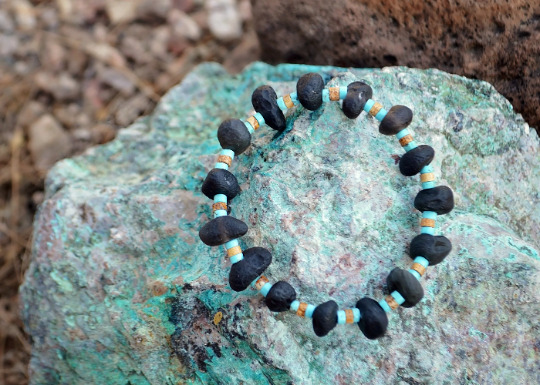
Saffordite Bracelet https://www.etsy.com/listing/1402025898/saffordite-arizona-tektite-cintamani-raw
Saffordites are a natural glass stone found only in one place on Earth – the Chihuahuan Desert southeast of Safford, Arizona. Often referred to as Arizona Tektites, they are really members of the obsidian glass family of rocks. Saffordites appear very black, like a piece of coal. But when they are viewed with a light from behind they truly show off their inner beauty. Their surface is usually pitted with cup-shaped depressions similar to moon-like craters and they vary from clear and sparkling to translucent, banded, opaque, and even the occasional rare find of a white “sheba”.
Saffordites have earned a lot of nicknames and are often called, the holy grail stone, the wish-fulfilling stone, or Cintamani. Metaphysically Saffordites are said to be the most powerful gemstones yet discovered, even more powerful than Moldavites . They carry a low magnetic frequency and thus are excellent for grounding with both root and crown chakras with many benefits for physical, emotional, and spiritual health.
#saffordite#safforditebracelet#arizonatektite#cintamani#safforditejewelry#moldavite#highvibrationstone#wishfullingstone#thoughtgem#obsidian#etsy#drymountaintreasures
1 note
·
View note
Text

Get ready to redefine your style and appearance with our novice Cintamani Saffordite.
0 notes
Text
Dumb SVSSS thought of the day: what if Mobei-jun is pretty damn young (14, not quite 15) when Shang Qinghua (20+however long he lived his first life) first meets him. And when he's relaxed and not in mortal danger (like when he's hogging Qinghua's bed) he's acting extremely childish, as emotionally neglected teenagers sometimes do. Just the brattiest of brats, somehow an unfortunate mix of 1. trained for deadly combat 2. already posessing very thorough education on demonic politics and rulership and 3. completely emotionally neglected and almost feral. Like. He's a lonely kid who very much needs a family connection and some hugs. He reminds Qinghua of some of the disciples An Ding gets who come from neglectful families, because getting their unwanted kids in a sect raises a family's prestige and there's a 'compensation' CQMS pays out to the 'gracious parents who give up their child' so it pays better than selling them to the slavers. (It's all just a ploy to make sure the people bring their kids there first, so there's less of a chance that they would end up in the clutches of demonic cultivators.)
So overworked, sleep deprived Qinghua ends up treating his demon brat the same way he treats the An Ding brats a few times. He can't help it! He knows that Mobei-jun will grow up to be like exactly his type, but right now he's just extremely little brother shaped (despite being really goddamn tall, what are they feeding young ice demons???) and Qinghua's brain just turns off the self preservation around him when he's tired enough apparently.
And Mobei-jun... Likes?? He likes this??? Nobody has babied him since the fallout with Linguang-jun when he was four, he's touch starved and needy for affection. The way his human expresses affection is not really the way he's used to, but it's still pleasant. It speaks to that shameful part of him that wanted to curl up and cry himself into oblivion when he was five and his father threw him out into the ice sheets and told him he's not allowed to return unless he kills something with his bare hands and then finds his way home.
So Shang Qinghua acquires a sticky, feral, demonic younger brother. He doesn't really mind as such, that's his blorbo and probably still his favorite person (and the reassurance that as long as he's Mobei-jun's emotional support human he's going to be kept safe is nice). But it really puts a lid on his non-existent dating life. Who would possibly date him now when they would have to contend with having Mobei-unlikely-to-ever-grow-out-of-his-stickiness-in-private-jun around too?
Yue Qingyuan. Yue Qingyuan would date him. He totally gets it, he has his own ill-tempered sticky little brother. Same situation, just with 95% less demonic energy and 80% more verbal sass. Shang Qinghua even ends up joking that they should set up playdates for those two. They are surprisingly effective.
What do you call it when you, your boyfriend, your little brother (feral cat, demon edition) and your boyfriend's little brother (feral cat, cultivator edition) are all cuddled up in a sleepy pile? Shang Qinghua isn't really sure, but it's comfier then it sounds, actually. Everyone appreciates Mobei-jun and his unshakably cool body temperature in the summer heat.
#svsss#Mobei-jun#shang qinghua#yue qingyuan#shen jiu#is there even a ship tag for yqy and sqh?#tc writes#I could kinda combine this with the snow leopard thing...#hmm now there's a story idea#something to work on next to cintamani I guess#I'm shelving it for now
319 notes
·
View notes
Text
youtube
All I Know of Love, a film by Emma Ruth Rundle and Geert Braekers
#music#emma ruth rundle#geert braekers#video#cedric demolis#adrien vanhaelter#marco mazzola#wolf carr#cintamani calise#ethan indorf#elisha brodsky#brandon daniel#josh winsor#matthew rich#blake armstrong#darcy sharpe#alex vicari#Youtube
29 notes
·
View notes
Note
Hi, I'm hoping you or someone reading knows the answer to this. That latest kimono pattern: does anyone know the name of the mark on the mallet's flat, round side? It's a stack of three ovals. It's not the jewel (usually on Daikokuten's rice sacks). It does appear in the older sculptures of the god. I've scoured all I can about uchide no kozuchi, but while I've seen it acknowledged, there's no name. The color symbolism also seems consistent, and again, no explanation found. Thanks for your consideration :)
I always saw this mark as indeed a stylised houju 宝珠 or tama 玉 (wish fulfilling jewel/Cintamani stone). Depictions do not always show the flaming parts or tip point, hôju are sometimes only pearl-like with those inner "ripples".
This vase is a good example:
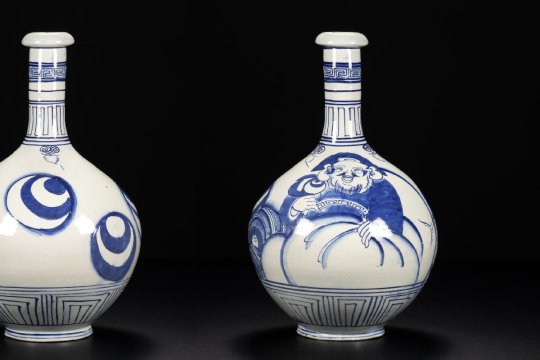
The uchide no kozuchi mallet is a pretty old item, appearing in tales since at least Heian. It sounds right that its magical properties echoing the famous Cintamani stone (and Daikokuten powers) had those symbolically merged overtime :)
#ask#pattern#houju#hoju#tama#wish fulfilling jewel#Cintamani stone#pearl#jewel#daikokuten#uchide no kozuchi#lucky mallet
39 notes
·
View notes
Text
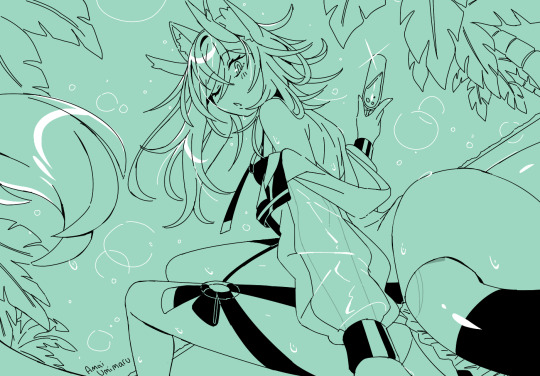

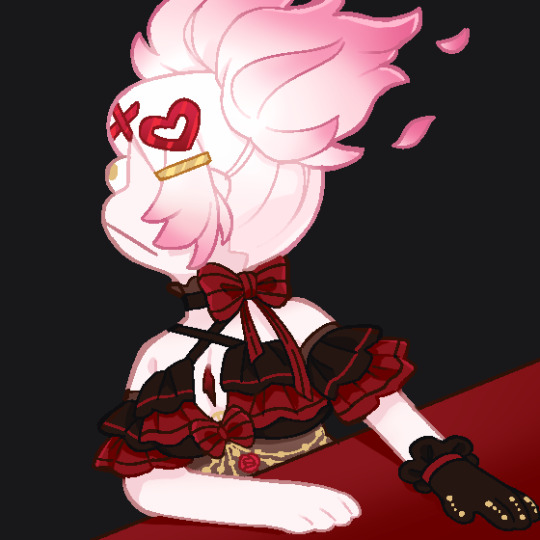
A batch of commissions that I finished recently!
For/Of the following VTubers
🐲Kip Cintamani
Twitter
Twitch
🎃Rurika (fan mascot)
Twitter
Twitch
👻Amonti Ado
Twitter
Twitch
2 notes
·
View notes
Text

The fifth is the Wish-fulfilling Jewel Monkey, who knows the path of heavenly bodies, discerns goodness from illusions, casts away Calamities, and satisfies all desires of thought.
harbinger of chaos is out, a Cintamani dropped on the eastern ocean to become a fifth mystical monkey is in.
532 notes
·
View notes
Text
Religious symbolisms on EP 12 in Christian and Buddhism/Hinduism perspectives
Isn’t it amusing that the final episode, EP12, fell on this year’s Lenten week? Rebirth and resurrection, the anastasis… those themes. Easter Sunday, the Christian Jesus alive again overcoming Death itself.
Isami Ao being reborn as Bravern’s latest persona, Burn Brave Big Bang, to defeat the all-powerful of all the Death Drives. Most of all, Lewis Smith coming back. His own resurrection, his own rebirth.



Burn Brave Big Bang is definitely Isami complete with his standard snarl


Verum Vita. What’s in a name? First off, it is a bastardised Latin that lacks an “e” at the end that means “the truth of life,” which sounds ironic as her lust for murder supersedes.
Upon introducing Verum Vita, a choir-like music could be heard chanting in Latin. (It was reminiscent of Carmina Burana’s “O, Fortuna” or “Dies Irae” by Guiseppe Verdi.) Then a pink lotus 🪷 appeared on her feet/bottom of her tower. A lotus has a significant meaning in different religions. In Christianity, flowers don’t often play an integral part in worship. Though, it represents purity and God’s creation of the universe. However, in Buddhism, Hinduism, Jainism and Sikhism, the lotus signifies purity of the heart, soul, and mind, and also, rebirth. It is an extraordinary exemplary as such that it remains pure and clean when coming out from the murky waters.
Usually, Hindu and Buddhism religious arts consist of deities either seated or floating on a lotus flower.
Verum Vita resembled the deity Kisshōten, the equivalent of Lakshmi in Japanese Buddhism. With a blossoming lotus under her feet, this goddess symbolises fertility, wealth, prosperity and beauty. The lotus under Verum Vita was not just any colour, but pink. In Buddhism, “the pink lotus flower is the supreme lotus and is considered to be the true lotus of Buddha.”


A few frames later, the lotus pedestal where she used to stand on transformed into marsh grass, which could be interpreted as the moment her fallen mask, her real intention, was revealed. Instead of holding a wish-fulfilling jewel called Cintamani, Verum Vita was holding a sword.
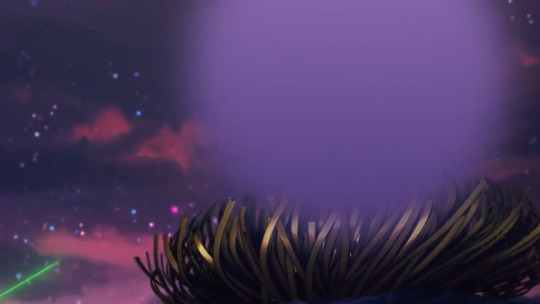
It is interesting the way this series subvert everything and use the religious imagery as the forces of evil subjugating the humankind.


Both Isami and Verum Vita both declared that they didn’t want to die. But there lies the difference between the two. When the first one wanted to save the world, the other strived to destroy it.
It feels like a mishmash of all beliefs fused into one huge spectacle to make this episode parts parody, parts fairy tale, and it is interesting to watch.
#bang brave bang bravern#yuuki bakuhatsu bang bravern#ao isami#verum vita#episode 12#wall of text#religious imagery#lulu
63 notes
·
View notes
Text
Imagine the chaos if the people in the indignity test suddenly came into the LCF world-
Dodam calling Cale 'the terrible bastard' while everyone is confused
Raon is happy knowing that even in another world, his human will always save him, just like he promised
Maybe even them fighting for Cale's attention
Both CHs look at each other warily but bond over the confusion that is known as Cale Henituse. Also, CH promises to teach indignity test CH how to become stronger to protect his new-found family. Cale is scared at this, as always
Alver laughing with a refreshed smile, while the younger him wonders if he's gone crazy when he sees how much paperwork he has.
Tiny Alver being happy when he sees that the dark elves, and them too, have been accepted by people. It only reaffirms the fact that he didn't make the wrong choice.
Baby KRS who is wary at first and sticks to CH like glue, however soon opens up with the help of the children. I can imagine Alver going 'Aigoo, why can't I have such a cute dongsaeng?'
However it's ruined when they teach baby KRS how to scam with a bright smile to get money (a critical hit to Alver)
(If you want angst then they wonder why KRS is here when he's so young, however they see how skinny he is still, his footsteps too quiet to not have been learned, the way his eyes were always looking for escapes and he hated people getting too close. The way he dissociates sometimes, just staring blankly at the wall. It's... unnerving, to say the least, to watch a child go so blank and unmoving.
It's clear that something terrible had happened, but both CH, KRS and Cale (to Alver) hold their silence, so all they can do is treat him with care.)
Tiny KRS and the children bonding.
Raon being taught by Eruhaben and Rosalyn.
If they still had the cintamani, maybe they could also dote on baby KRS and how cute he was as a kid, asking 20yr KRS why couldn't he smile at them like that and how such a cute kid turned into such a grump- (tsundere-
Them helping each other out for the future, and sharing concepts/ideas from their worlds.
Vicross having to babysit but he doesn't mind
Ron noticing the similarities between KRS and Cale and deciding to pay more attention to the two of them
Anyways, wow. This got way longer than I expected-
#I don't have the motivation or skills to write this#So I'll just ramble about it instead#kim rok soo#trash of the count's family#lout of the count’s family#alver crossman#alberu crossman#Tcf#lcf#cale henituse#choi han#raon miru#I'm super curious about CH's indignity test#The author really trolled us by giving snippets but not all of it#I wanted to see his reactions and how he solved everything (plus him most likely beating up KRS's uncle)#We were robbed of tiny KRS too :(#I hope it comes up again at least in side stories if there's going to be any#If it doesn't then I'll just write it myself-#beacrox molan
325 notes
·
View notes
Text

Bodhisattva Cintāmaṇicakra, 13th century
Kenji 1, Kamakura period, Japan
Wood, joined block construction
Height 32.7 cm
This statue was carved from a cypress wood (hinoki) which was dyed in a red color to imitate sandalwood. The robe was decorated with cut gold leaf. The influence of Chinese Song dynasty can be seen on a decorative hair style and a draping robe. This statue was originally the principal image of Zōkezō-in in Shitennō-ji Temple, Osaka Prefecture. The various objects including sutra were deposited in the hollow of the statue.
Collection of the Nara National Museum
#Avalokitesvara#Buddhism#bodhisattva#figure#religion#cintamani#cintamanicakra#13th century#Kamakura period#Japanese#bodisattva#sculpture#wood#cypress#gilding#gold#art#art history#Nara National Museum#iconography
5 notes
·
View notes
Text
Reactions to the Mistaken One's Chapter 165
TL;DR - Cale versus the red scale. The Imoogi's story. Red crown from the novel cover is finally here!
Soos?
LSH = ❌
CJS = ✅
Cale vs Red Scale
There was a brief battle between Cale and the red scale. The scale was stuck in Cale's hand, and wouldn't fall off. Add to Cale's problems was the white crown coveting the red scale so much that Cale had to slam it on the ground several times. Thankfully, using the Fire AP was the answer to everything, and it weakened the pressure from the scale.
The Young Imoogi, Perpetual
Fist King narrated the imoogi's tale last chapter, but today, Cale got a glimpse of the true story from the imoogi's perspective. I won't repeat what happened, but the tale from the imoogi's side was sadder and more touching. 🥲
If there were some differences, it was the imoogi left on its own to search for fire instead of being left by the child in the mountains. And the reverse scale was not actually a scale. It was the cintamani itself, but the imoogi's friend had forged it into the form of a scale to make it look prettier.
The imoogi had the voice of a young girl the same age as On, and could even transform into a half-human, half-dragon. Her human friend gave her the name "Perpetual" in her hopes for the imoogi to live long.
There were also the sad death scene and the imoogi's realization that she filled her cintamani not with nature's fire but human warmth and affection... 😭
Red Crown From Novel Cover is Here
So after the imoogi showed her past to Cale, the scale transformed into a small candle-like fire. And what we were all waiting for happens! White crown + Maxi's crown + imoogi's fire = Red Crown!
The three fused, and Cale was left standing with a red crown on his head. CJS remarked that it suited Cale. The chapter ended with Cale laughing out loud as he got what he wanted... Or maybe not. He did postpone unsealing the Fire AP because he prioritized the crown fusion.
Ending Remarks
Well, Cale was in his KRS form and dressed in murim clothes, so it was still far from the novel cover... But at least, we now know where the red crown came from! Next mystery is the background. Which world is that from?
Anyway, today's chapter was half-sad, and half-exciting. As for the next chapter, I'm not sure what's going to happen... If I recall, there was supposed to be another elixir from Fist King, the earth attribute one? Perhaps we'll have more elixir consuming next chapter.
113 notes
·
View notes
Text
Pearl Correspondences & Uses in Witchcraft
Friendly reminder that this post was available for early access over on my Patreon! Unlock early access to my future content (as well as exclusive access to my research notes, free tarot readings, digital goodies, access to my online library, and TONS more) by subscribing to my Patreon for as little as $2/month!
In ancient Chinese culture, pearls were used in artwork, folktales, and charms to represent wishes, fortunes, gratitude, and even the moon:
Marquis of Sui’s Pearl, a gemstone in a folktale dating back to the Warring States period (475-221 BCE), is given to a leader, Sui, from an injured snake that he nurses back to health, as a symbol of gratitude.
In Hindu and Buddhist traditions, The Chintamani (equivalent to the importance of The Philosopher’s Stone in alchemy) is known as a wish-fulfilling jewel that is sometimes depicted as a pearl.
In Chinese artwork, dragons may be seen holding or playing with a “flaming pearl” – in this context, some believe the pearl may be representative of “an object of great value that enhances the benign dragon who treasures it”, however it is more commonly (especially in Westerners) believed to be a cosmological symbol of the moon – in fact, there is an ancient belief that full moons are solid pearls, while new moons are hollow pearls.
In holistic circles, pearl powder is also known to help you with longevity, beauty, bone-health, among many other (non-FDA approved) benefits – and in Ayurvedic medicine, pearl is said to be an antidote for poison, and it was also used in love potions.
Knowing the traditional symbolism of pearls in Chinese and Eastern cultures, as well as its (supposed) medical benefits and Ayurvedic uses, we can create our own Correspondences for Utilizing Pearls in Witchcraft:
The Moon
The inner/subconscious-self
Wishes
Gratitude
Abundance
Love
Beauty
Longevity, good health
Pisces, cancer
Hidden knowledge
Uses for pearls (or pearl powder) in modern witchcraft:
Use pearl powder as highlighter in makeup for an easy glamor-spell
Mix with salt and other herbs associated with abundance to make “money-salt” for money spells
Add whole pearls or sprinkle pearl powder in your money bowl
Blow pearl powder onto your front door at the beginning of each month to bring abundance to your home
Write down a secret or something you want to get off your chest, and bury it with a pearl to keep it ‘hidden away’ from others
Make a wish with a pearl by leaving it out in a rainstorm, or dropping it into a natural body of water (pond, lake, etc).
Offerings to sea-related or beauty-realted deities

Fun pearl facts:
Genuine pearls (and pearl powder) doesn’t burn! Pearls may discolor, but they shouldn’t go up in flames.
Pearls are made as oysters try to protect themselves from irritants or parasites – they add layers and layers of this ‘pearl’ coating to intruders, and viola!
Pearls are the only gemstone that come from a living creature
Pearls come in many colors
Pearls are obtained from oyster farming – which is actually beneficial to the environment! Additionally, pearls can be harvested without killing oysters.
Be careful when shopping for pearls – many places do not sell genuine pearls and they may be fake. Use caution when looking to purchase!
Sources:
https://en.wikipedia.org/wiki/Marquis_of_Sui's_pearl
https://sci-hub.ru/https://doi.org/10.2307/1512907
https://en.wikipedia.org/wiki/Cintamani
https://en.wikipedia.org/wiki/Eight_Treasures
#crystals#gemstone#gemstones#crystal witch#pearls#pearl#witchcraft#correspondences#spells#spell#love spell#spell book#grimoire#thevirginwitch#witchy#sea witch#witch#witchblr#witches of tumblr#pagan
155 notes
·
View notes
Text
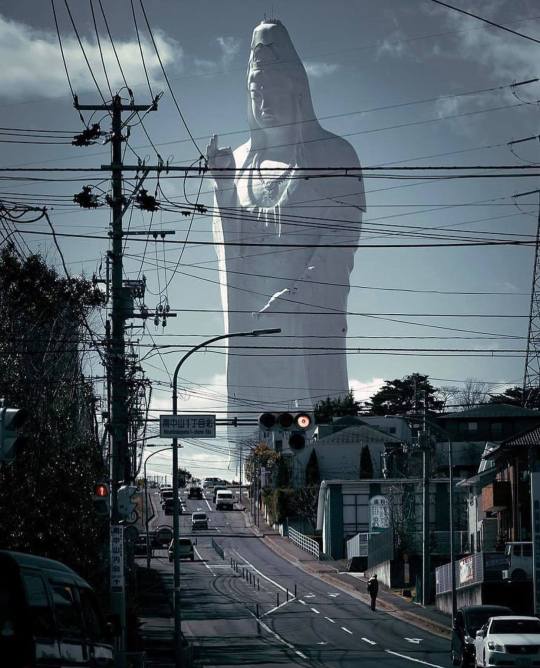
Sendai Tendou Byakue Daikannon (仙台天道白衣大観音), located in Sendai, Japan. It portrays the bodhisattva Byakue Kannon (白衣観音, "White-robed Kannon", a.k.a. The Goddess of Mercy) bearing the cintamani gem (如意宝珠, Nyoihōju) in her hand.
It is the tallest statue of a goddess in Japan and as of 2023 is the 8th tallest statue in the world at 100 metres (330 ft).
60 notes
·
View notes
Text

☀ SHRI RADHA KRISHNA ☀
“The only religious priniciple that the living entity has to follow now is the continuous chanting and rememberance of the Hare Krishna maha-mantra."~Hari-nama-cintamani
Hare Krishna Hare Krishna Krishna Krishna Hare Hare
Hare Rama Hare Rama Rama Rama Hare Hare
28 notes
·
View notes